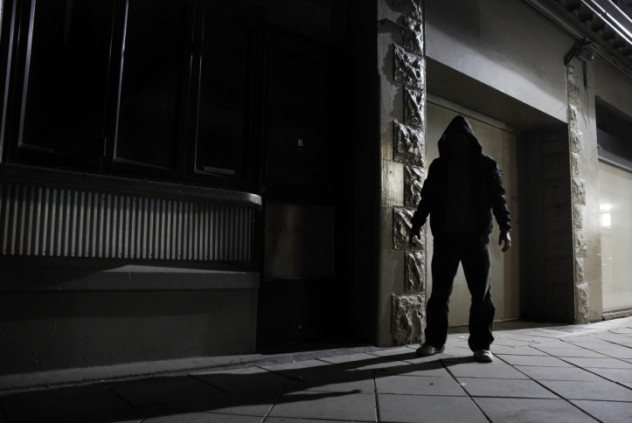 Music
Music  Music
Music  History
History 10 Less Than Jolly Events That Occurred on December 25
 Weird Stuff
Weird Stuff 10 Funny Ways That Researchers Overthink Christmas
 Politics
Politics 10 Political Scandals That Sent Crowds Into the Streets
 Weird Stuff
Weird Stuff Ten Bizarre Facts About The Doge Meme
 Our World
Our World 10 Ways Your Christmas Tree Is More Lit Than You Think
 Movies and TV
Movies and TV The 10 Coolest Stars to Set Sail on The Love Boat
 History
History 10 Things You Didn’t Know About the American National Anthem
 Technology
Technology Top 10 Everyday Tech Buzzwords That Hide a Darker Past
 Humans
Humans 10 Everyday Human Behaviors That Are Actually Survival Instincts
 Music
Music 10 Surprising Origin Stories of Your Favorite Holiday Songs
 History
History 10 Less Than Jolly Events That Occurred on December 25
 Weird Stuff
Weird Stuff 10 Funny Ways That Researchers Overthink Christmas
Who's Behind Listverse?

Jamie Frater
Head Editor
Jamie founded Listverse due to an insatiable desire to share fascinating, obscure, and bizarre facts. He has been a guest speaker on numerous national radio and television stations and is a five time published author.
More About Us Politics
Politics 10 Political Scandals That Sent Crowds Into the Streets
 Weird Stuff
Weird Stuff Ten Bizarre Facts About The Doge Meme
 Our World
Our World 10 Ways Your Christmas Tree Is More Lit Than You Think
 Movies and TV
Movies and TV The 10 Coolest Stars to Set Sail on The Love Boat
 History
History 10 Things You Didn’t Know About the American National Anthem
 Technology
Technology Top 10 Everyday Tech Buzzwords That Hide a Darker Past
 Humans
Humans 10 Everyday Human Behaviors That Are Actually Survival Instincts
10 Terrifying Cases Of Sadistic Stalkers
There aren’t many things that make a person feel more helpless than being stalked and harassed by a mentally unbalanced individual. A stalker’s obsession with their victim can be so strong that any rejection of their unwanted advances can lead to violence and they will often have little regard for the legal consequences. Believe it or not, there was once a time when stalking victims had very little protection, as anti-stalking laws have only been on the books for a few decades. Unfortunately, as many of these terrifying cases will demonstrate, someone usually had to be victimized before the proper laws were enacted.
10 Tatiana Tarasoff & Prosenjit Poddar

Tatiana Tarasoff is a prime example of a stalking victim who did not have the proper laws in place to protect her. In 1968, Tatiana became friends with Prosenjit Poddar, a University of California–Berkeley student from India. They shared a friendly kiss at a New Year’s Eve party, which gave Prosenjit the impression that Tatiana was attracted to him, but Tatiana soon clarified that she was not interested in a romantic relationship. Prosenjit could not handle the rejection and developed an unhealthy obsession with Tatiana, often secretly recording their conversations together.
In the summer of 1969, Tatiana left on a trip to Brazil, so Prosenjit went to see Dr. Lawrence Moore, a psychologist at the university hospital. During one of their therapy sessions, Prosenjit openly expressed his intentions to kill Tatiana. Dr. Moore believed Prosenjit was suffering from paranoid schizophrenia and informed the campus police, but after police interviewed Prosenjit, they determined that he was not dangerous and decided to let him go. When Tatiana returned from Brazil, she was not informed about Prosenjit’s threats against her. On October 27, Prosenjit went to Tatiana’s house and shot her with a pellet gun before stabbing her 14 times.
Prosenjit immediately turned himself in and was convicted of second-degree murder, but his conviction was overturned because the jury at his trial was not properly instructed. Rather than retry him, the state elected to deport Prosenjit back to India after serving only five years. Tatiana’s family would sue the hospital for their failure to warn her about Prosenjit’s threats. This led to a Supreme Court case, Tarasoff v. Regents of the University of California, which ruled that mental health professionals have a duty to forgo confidentiality and warn individuals who are threatened by patients.
9 Theresa Saldana & Arthur Richard Jackson

These days, it’s not uncommon to hear news stories about famous celebrities being stalked by obsessive fans. Thankfully, most of these situations do not escalate into violence. That’s not the case with one of the first celebrity stalking cases to garner national attention, involving actress Theresa Saldana.
In 1982, the 27-year-old Saldana had already been featured in such prominent films as Raging Bull and I Wanna Hold Your Hand, but it was her performance in the movie Defiance that drew the attention of an obsessed fan named Arthur Richard Jackson. Jackson was a 47-year-old drifter from Aberdeen, Scotland who had traveled all the way across the globe to illegally enter the United States. Jackson’s plan was to find Saldana, kill her, and join her in the afterlife after he was executed for her murder.
Jackson first hired a private investigator to obtain the phone number of Saldana’s mother. Pretending to be a representative for director Martin Scorsese, he called her and claimed he needed to contact Saldana about a possible film role. After Saldana’s mother provided her daughter’s West Hollywood address, Jackson traveled there and waited outside. When Saldana exited her residence, Jackson stabbed her 10 times with a hunting knife.
The only reason Saldana survived is because a deliveryman named Jeffrey Fenn rushed to her rescue and subdued Jackson. Saldana made a full recovery and Jackson was given a 12-year sentence for attempted murder. Jackson continued to write threatening letters to Saldana while in prison, but would be extradited to the United Kingdom to stand trial for another unrelated murder. After her recovery, Saldana became a prominent advocate for victim’s rights and even decided to relive her traumatic ordeal by playing herself in the made-for-TV movie Victims for Victims: The Theresa Saldana Story.
8 Laurie Show & Lisa Michelle Lambert

In 1991, a 16-year-old student at Conestoga Valley High School in Lancaster, Pennsylvania named Laurie Show became the victim of a nonstop ordeal of stalking and harassment. Laurie was targeted by a classmate named Lisa Michelle Lambert, who was upset that Laurie had briefly dated a mutual acquaintance, Lawrence “Butch” Yunkin. Michelle had recently become pregnant with Butch’s child and was obsessively jealous of Laurie, believing that she was trying to steal her boyfriend. In actuality, Butch had allegedly raped Laurie and she wanted nothing to do with him. Nonetheless, Michelle frequently harassed Laurie, taunting her with obscene phone calls and openly threatening her whenever she was in public. Laurie’s mother, Hazel Show, attempted to file assault charges against Michelle, but it did little to stop her.
On December 21, Hazel received a phone call from a counselor, asking her to drop by the school for a meeting about Laurie. It turned out the call was just a diversion to get Hazel out of the residence, leaving Laurie alone. When Hazel returned home, she was horrified to discover that her daughter had been murdered. Laurie’s throat had been slashed and she had been stabbed several times. She used her dying words to tell her mother that Michelle was responsible.
The next day, Michelle was arrested, along with an accomplice named Tabitha Buck. Butch Yunkin was also arrested for dropping the two girls off at Laurie’s residence, but claimed he did not participate in the murder. Michelle and Tabitha were both given life sentences, while Butch received a lesser sentence for testifying against them. The incident prompted Hazel Show to campaign for stronger anti-stalking laws in Pennsylvania, which went into effect in June 1993.
7 Priyadarshini Mattoo & Santosh Singh

One of the most controversial criminal cases in the history of India involved the murder of a 25-year-old law student named Priyadarshini Mattoo. Priyadarshini was attending Delhi University when she drew the attention of another student named Santosh Singh. Throughout 1995, Santosh spent the year constantly stalking and harassing Priyadarshini until she formally complained to the police. They provided her with a personal security officer, but this failed to dissuade Santosh. On January 23, 1996, Priyadarshini was murdered at her home in New Delhi. She had been raped and her face had been repeatedly beaten with a motorcycle helmet before she was strangled to death with a wire.
A witness had seen Santosh entering the house shortly before her death, so he was arrested and charged with murder. However, Santosh’s father just happened to an Inspector-General on the police force at the time of Santosh’s trial and the Central Bureau of Investigation did an inadequate job of investigating the murder. In 1999, Santosh was acquitted of the crime, a decision which was met with much anger from the public. While reading the verdict, the judge stated that he believed Santosh committed the crime, but because of the CBI’s shoddy investigation, he was forced to give the accused the benefit of the doubt. This verdict was eventually appealed to the Delhi High Court, and in 2006, the decision was reversed and Santosh was sentenced to death. In 2010, the sentence was commuted to life imprisonment.
6 Mary Stauffer & Ming Sen Shiue

Ming Sen Shiue was originally born in Taiwan, but his family immigrated to Minnesota when he was a child. Ming attended Alexander Ramsey High School in Roseville and developed a crush on his ninth-grade algebra teacher, Mary Stauffer. Unfortunately, this crush eventually morphed into a deadly obsession that lasted 15 years. Throughout the 1970s, Ming attempted to track Mary down and relentlessly stalked her. On May 16, 1980, Mary and her eight-year-old daughter, Elizabeth, went to a beauty salon in Rosedale, where Ming kidnapped them at gunpoint as they were leaving. They were both tied up and smuggled into the trunk of Mary’s car.
Ming drove away, but soon decided to pull over because his captives kept making noises inside the trunk. This caught the attention of a six-year-old boy named Jason Wilkman, but when he approached the vehicle, Ming threw him into the trunk as well. Ming drove the boy to a wildlife refuge and beat him to death with a metal rod before taking the Stauffers to his home. Mary was repeatedly raped as both she and her daughter were held captive at Ming’s house for nearly two months. Ming even told Mary that the grade she gave him in algebra had blemished his otherwise perfect record and cost him a chance for a scholarship.
Finally, on July 7, they escaped and called for help. Shortly thereafter, Ming was arrested at his workplace. During the subsequent trial, Ming somehow managed to smuggle a knife into court and slash Mary’s face while she testified. In the end, Ming was sentenced to 40 years in prison for murder and given an additional 30 years for kidnapping.
5Collette Dwyer & Derrick Todd Lee

In 2002, Collette Dwyer was living through a terrible nightmare. She had been stalked and harassed by a man she believed to be a serial killer, but could not get the police to take her seriously. Dwyer lived in St. Francisville, Louisiana and became acquainted with Derrick Todd Lee, a customer who frequently hung around her place of employment. Lee soon developed an obsession with Dwyer, who rebuffed his advances.
In 1999, Lee forced his way into Dwyer’s apartment, claiming that he wanted to love and “take care” of her. She refused Lee’s offer to accompany him to Lafayette, a decision which may have saved her life. Lee was charged with stalking and received probation, but soon went to prison for another unrelated crime. Two years later, Lee was released and started stalking Dwyer again.
Not long after that, Dwyer heard about the murder of a Baton Rouge woman named Charlotte Murray Pace and became convinced Lee was responsible. She notified the police, who investigated Lee, but didn’t bother to take his DNA because they were convinced the perpetrator was white. Dwyer contacted police again after the murder of a woman named Pam Kinamore, but they still didn’t believe Lee was responsible.
Finally, in May 2003, Lee was questioned for the rape of another woman and finally had his DNA taken. The DNA wound up linking him to the murders of Pace and Kinamore. In total, Lee’s DNA would be linked to the murders of seven women and he was nicknamed “The Baton Rouge Serial Killer.” Lee was sentenced to death for his crimes and currently sits on death row at Louisiana State Penitentiary. Sadly, three of Lee’s murders might have been prevented, had the police not ignored Collette Dwyer.
4 Sandy Shaw & James “Cotton” Kelly

In 1986, there were no stalking laws on the books, which forced 15-year-old Sandy Shaw to make an unfortunate decision she would regret. Sandy lived in Las Vegas and was relentlessly harassed by 21-year-old James “Cotton” Kelly, who kept propositioning her to pose for nude pictures. Cotton called Sandy’s house so often that her mother finally contacted the police, but since there were no stalking laws in place, there was nothing they could do. In desperation, Sandy turned to an 18-year-old friend named Troy Kell, asking him to rough Cotton up until he backed off.
On September 29, Sandy, Troy, and another teenager named Billy Marrett drove Cotton out into the desert to enact their plan. To Sandy’s surprise, Troy pulled out a gun and shot Cotton six times in the face. In the ensuing days, Sandy allegedly brought some teenage friends to see Cotton’s corpse. When one of these friends reported the body to the police, the three perpetrators were arrested for the crime that would be dubbed the “Show and Tell Murder.”
Billy took a plea bargain to testify against Troy, who was given a life sentence for the murder. Even though Sandy claimed she did not know that Troy would kill Cotton, she was also sentenced to life in prison without the possibility of parole. Years later, one of Sandy’s friends confessed that he took the teens to view Cotton’s body and that Sandy was not present. Sandy always expressed genuine remorse about what happened and the State Board of Pardons and Parole eventually believed her claims that she was just a desperate stalking victim who did not intend for anyone to get killed. Sandy’s life sentence was commuted and she was finally paroled in December 2007.
3 Randi Barber & Gary Dellapenta

The invention of the Internet led to the invention of a new form of harassment called “cyberstalking,” which wasn’t criminalized until 1999. The first person to be charged under this new statute was a 50-year-old Los Angeles security guard named Gary Dellapenta. Three years beforehand, Dellapenta had developed an obsessive attraction to Randi Barber, a younger woman from his church. Dellapenta frequently followed and stalked Barber, who always spurned his advances. The harassment eventually became so bad that Barber convinced the church’s elders to ban Dellapenta from the congregation. Dellapenta then decided to go online to exact sadistic revenge.
During the summer of 1998, Dellapenta signed up for several sex-related chat rooms and began to impersonate Barber. Dellapenta left several personal ads under Barber’s name, stating that she fantasized about being raped by men who showed up at her apartment. Unfortunately, he also attached Barber’s address to these ads. During one five-month period, six men would show up at Barber’s apartment, claiming they were there to fulfill her rape fantasies.
Since Barber never went online and did not even own a computer, she was absolutely horrified and turned all these visitors away. Dellapenta even created a fake email address under Barber’s name, and whenever anyone contacted him, Dellapenta would provide instructions about how to break into her apartment and bypass the security system. Thankfully, Barber found out what Dellapenta was doing before she was physically harmed. Dellapenta was arrested on charges of cyberstalking and sentenced to six years in prison.
2 Rebecca Schaeffer & Robert John Bardo

One of the most tragic celebrity stalking cases of all time involved 21-year-old actress Rebecca Schaeffer. In 1989, Schaeffer was best known for her role on the sitcom My Sister Sam. Her film career was starting to take off, as she was slated to audition for a role in The Godfather Part III.
She had also drawn the attention of Robert John Bardo, an obsessed 19-year-old fan from Tucson, Arizona who had built a personal shrine to Schaeffer in his room. He sent numerous letters to Schaeffer and even made two attempts to visit her on the set of My Sister Sam. However, Bardo became horribly disappointed when he watched Schaeffer perform a sex scene in one of her films and decided she needed to be “punished.” He obtained Schaeffer’s home address through a private investigator and set forth to Los Angeles.
On the morning of July 18, Bardo visited Schaeffer’s apartment and buzzed her door. When Bardo told Schaeffer he was her biggest fan, she politely asked him to leave. Shortly afterward, Bardo buzzed Schaeffer again. This time, when Schaeffer answered the door, Bardo pulled out a gun and shot her to death. Bardo returned to Tucson, but was quickly arrested after tipping off his sister about the murder. He wound up being charged with first-degree murder and received a life sentence.
This tragedy would ultimately lead to the enactment of stronger anti-stalking laws in California. Since Bardo’s private investigator had obtained Schaeffer’s address through the California Department of Motor Vehicles, the Driver’s Privacy Protection Act was passed, which made it illegal for anyone to obtain personal information through the DMV.
1 Laura Black & Richard Farley

In April 1984, 35-year-old Richard Farley was a veteran employee at Electromagnetic Systems Labs Incorporated, a defense contractor in Sunnyvale, California. When 22-year-old Laura Black was hired to work at ESL, Farley instantly became obsessed with her. He constantly asked Black out and left her gifts, but she always turned him down.
Over the next four years, Farley’s obsession with Black became very unsettling. He wrote her over 200 letters and showed up at her residence so frequently that she was forced to move several times. Black finally went to ESL’s human resources department to complain about Farley, who was ordered to attend counseling sessions and leave Black alone. However, Farley’s behavior became even more threatening and ESL finally let him go in May 1986.
In spite of this, Farley’s harassment of Black did not come to an end and she would file a temporary restraining order against him on February 8, 1988. A hearing for the matter was scheduled in court on February 17. However, the day before the hearing, Farley drove his motor home to the ESL parking lot. He had several different guns with him, along with over 1,000 rounds of ammunition. After shooting his first victim in the parking lot, Farley proceeded into the ESL building with all of his weapons and opened fire.
Farley shot several employees before arriving at Black’s office and shooting her twice. Farley engaged the police in a five-hour standoff before he decided to surrender. While Black survived, a total of seven employees lost their lives and three more were wounded. Farley was found guilty of seven counts of first-degree murder and currently sits on death row at San Quentin.
Robin Warder is a budding Canadian screenwriter who has used his encyclopedic movie knowledge to publish numerous articles at Cracked.com. He is also the co-owner of a pop culture website called The Back Row and recently worked on a sci-fi short film called Jet Ranger of Another Tomorrow. Feel free to contact him here.








